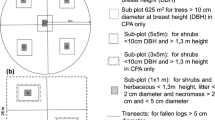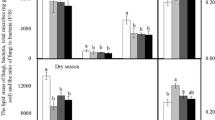Abstract
Background and aims
Forest composition in North America has undergone important changes since the European settlement. The effects of such alterations on soil properties remain largely unknown. This study aims to understand the long-term effects of shifts in forest composition on soil properties.
Methods
Using data from 130 plots measured over an eighty-year period, the relationships between stand composition (both current and past), parent material and current soil chemical properties were studied with redundancy analyses.
Results
Results indicated that the parent material remained the dominant factor explaining soil properties, followed by current tree species composition. No legacy effect of past forest composition was found, but shifts in forest composition explained part of the current soil properties. Specifically, an increase in balsam fir was related to higher C/N ratio in the O-horizon, while an increase in maple species was related to higher net nitrification in both the O and B-horizons, and higher extractable P in the B-horizon.
Conclusion
Our results suggest that increasing the maple component at the expense of conifers over several decades may enhance nutrient availability in the O-horizon.



Similar content being viewed by others
References
Adamczyk B, Adamczyk S, Smolander A, Kitunen V (2011) Tannic acid and Norway spruce condensed tannins can precipitate various organic nitrogen compounds. Soil Biol Biochem 43:628–637
Alban DH (1982) Effects of nutrient accumulation by aspen, spruce, and pine on soil properties. Soil Sci Soc Am J 46:853–861
Augusto L, De Schrijver A, Vesterdal L, Smolander A, Prescott C, Ranger J (2015) Influences of evergreen gymnosperm and deciduous angiosperm tree species on the functioning of temperate and boreal forests. Biol Rev 90:444–466
Averill C, Turner BL, Finzi AC (2014) Mycorrhiza-mediated competition between plants and decomposers drives soil carbon storage. Nature 505:543–545
Ayres E, Steltzer H, Berg S, Wallenstein MD, Simmons BL, Wall DH (2009) Tree species traits influence soil physical, chemical, and biological properties in high elevation forests. PLoS One 4:e5964
Bal TL, Storer AJ, Jurgensen MF, Doskey PV, Amacher MC (2015) Nutrient stress predisposes and contributes to sugar maple dieback across its northern range: a review. Forestry: An International Journal of Forest Research 88:64–83
Baldwin IT, Olson RK, Reiners WA (1983) Protein binding phenolics and the inhibition of nitrification in subalpine balsam fir soils. Soil Biol Biochem 15:419–423
Bauhus J, Paré D, Côté L (1998) Effects of tree species, stand age and soil type on soil microbial biomass and its activity in a southern boreal forest. Soil Biol Biochem 30:1077–1089
Borcard D, Gillet F, Legendre P (2011) Chapter 6: canonical ordination. In: Numerical ecology with R. Springer, New York
Boucher Y, Arseneault D, Sirois L (2006) Logging-induced change (1930–2002) of a preindustrial landscape at the northern range limit of northern hardwoods, eastern Canada. Can J For Res 36:505–517
Brown CD, Vellend M (2014) Non-climatic constraints on upper elevational plant range expansion under climate change. Proc R Soc Lond B Biol Sci 281:20141779
Côté B, Fyles JW (1994) Nutrient concentration and acid-base status of leaf litter of tree species characteristic of the hardwood forest of southern Quebec. Can J For Res 24:192–196
Danneyrolles V, Arseneault D, Bergeron Y (2016) Long-term compositional changes following partial disturbance revealed by the resurvey of logging concession limits in the northern temperate forest of eastern Canada. Can J For Res 46:943–949
Dupuis S, Arseneault D, Sirois L (2011) Change from pre-settlement to present-day forest composition reconstructed from early land survey records in eastern Québec, Canada. J Veg Sci 22:564–575
Finzi AC, Canham CD, Van Breemen N (1998a) Canopy tree-soil interactions within temperate forests: species effects on pH and cations. Ecol Appl 8:447–454
Finzi AC, Van Breemen N, Canham CD (1998b) Canopy tree-soil interactions within temperate forests: species effects on soil carbon and nitrogen. Ecol Appl 8:440–446
Fisher JB, Sweeney S, Brzostek ER, Evans TP, Johnson DJ, Myers JA, Bourg NA, Wolf AT, Howe RW, Phillips RP (2016) Tree-mycorrhizal associations detected remotely from canopy spectral properties. Glob Chang Biol 22:2596–2607
Foster NW, Hazlett PW, Nicolson JA, Morrison IK (1989) Ion leaching from a sugar maple forest in response to acidic deposition and nitrification. Water Air Soil Pollut 48:251–261
Fuller JL, Foster DR, McLachlan JS, Drake N (1998) Impact of human activity on regional Forest composition and dynamics in Central New England. Ecosystems 1:76–95
Held M, Jones-Held S (2014) Long-term Forest changes in northeastern Pennsylvania. Castanea 79:138–146
Hendershot W, Lalande H, Duquette M (2007) Ion exchange and exchangeable cations. In: Carter M, Gregorich E (eds) Soil sampling and methods of analysis, 2nd edn. CRC Press, Boca Raton, pp 173–178
Hijazi RH, Jernigan RW (2009) Modelling compositional data using Dirichlet regression models. Journal of Applied Probability & Statistics 4:77–91
Houle D, Moore JD, Ouimet R, Marty C (2014) Tree species partition N uptake by soil depth in boreal forests. Ecology 95:1127–1133
Jenny H (1941) Factors of soil formation: a system of quantitative pedology. McGraw-Hill, New York
Klironomos JN (1995) Arbuscular mycorrhizae of Acer saccharum in different soil types. Can J Bot 73:1824–1830
Kroetsch D, Wang C (2007) Particle size distribution. In: Carter M, Gregorich E (eds) Soil sampling and methods of analysis, 2nd edn. CRC Press, Boca Raton (USA)
Lafleur B, Paré D, Munson AD, Bergeron Y (2010) Response of northeastern north American forests to climate change: will soil conditions constrain tree species migration? Environ Rev 18:279–289
Laganière J, Paré D, Bradley RL (2010) How does a tree species influence litter decomposition? Separating the relative contribution of litter quality, litter mixing, and forest floor conditions. Can J For Res 40:465–475
Laganière J, Paré D, Bergeron Y, Chen HYH (2012) The effect of boreal forest composition on soil respiration is mediated through variations in soil temperature and C quality. Soil Biol Biochem 53:18–27
Légaré S, Paré D, Bergeron Y (2005) Influence of aspen on forest floor properties in black spruce-dominated stands. Plant Soil 275:207–220
Legendre P, Gallagher ED (2001) Ecologically meaningful transformations for ordination of species data. Oecologia 129:271–280
Legendre P, Legendre LFJ (2012) Chapter 11 - canonical analysis. In: Numerical ecology (3rd ed.), volume 24. Developments in environmental modelling. Elsevier, Oxford
Legendre P, Oksanen J, ter Braak CJF (2011) Testing the significance of canonical axes in redundancy analysis. Methods Ecol Evol 2:269–277
Lorenz K, Preston CM, Raspe S, Morrison IK, Feger KH (2000) Litter decomposition and humus characteristics in Canadian and German spruce ecosystems: information from tannin analysis and 13C CPMAS NMR. Soil Biol Biochem 32:779–792
Lovett GM, Weathers KC, Arthur MA, Schultz JC (2004) Nitrogen cycling in a northern hardwood forest: do species matter? Biogeochemistry 67:289–308
Maynard DG, Kalra YP, Crumbaugh JA (2007) Nitrate and exchangeable ammonium nitrogen. In: Carter M, Gregorich E (eds) Soil sampling and methods of analysis, 2nd edn. CRC Press, Boca Raton
McKeague JA (1976) Manual of soil sampling and methods of analysis. Canadian Society for Soil Science, Ottawa
Ministère des Forêts, de la Faune et des Parcs du Québec - Direction des inventaires forestiers - Forêt Québec (ACRIGéo). 2012. Couche écoforestière 22C08–0201, Inventaire du quatrième décennal
Nowacki GJ, Abrams MD (2015) Is climate an important driver of post-European vegetation change in the Eastern United States? Glob Chang Biol 21:314–334
Oksanen J, Blanchet FG, Friendly M, Kindt R, Legendre P, McGlinn D, Minchin PR, O’Hara RB, Simpson GL, Solymos P, Henry M, Stevens H, Szoecs E, Wagner H (2016) Vegan : community ecology package. R Package version 2:4–1
Paré D, Bernier P, Lafleur B, Titus BD, Thiffault E, Maynard DG, Guo X (2013) Estimating stand-scale biomass, nutrient contents, and associated uncertainties for tree species of Canadian forests. Can J For Res 43:599–608
Pennington W (1986) Lags in adjustment of vegetation to climate caused by the pace of soil development. Evidence from Britain. Plant Ecol 67:105–118
Peres-Neto PR, Legendre P, Dray S, Borcard D (2006) Variation partitioning of species data matrices: estimation and comparison of fractions. Ecology 87:2614–2625
Putnam RC, Reich PB (2017) Climate and competition affect growth and survival of transplanted sugar maple seedlings along a 1700-km gradient. Ecol Monogr 87:130–157
R Development Core Team (2016) R: a language and environment for statistical computing. R Foundation for Statistical Computing, Vienna
Raulund-Rasmussen K, Vejre H (1995) Effect of tree species and soil properties on nutrient immobilization in the forest floor. Plant Soil 168:345–352
Reich PB, Oleksyn J, Modrzynski J, Mrozinski P, Hobbie SE, Eissenstat DM, Chorover J, Chadwick OA, Hale CM, Tjoelker MG (2005) Linking litter calcium, earthworms and soil properties: a common garden test with 14 tree species. Ecol Lett 8:811–818
Robitaille A, Saucier JP (1998) Paysages régionaux du Québec méridional. [Québec]: Gouvernement du Québec, Ministère des ressources naturelles, Sainte-Foy
Smolander A, Kanerva S, Adamczyk B, Kitunen V (2012) Nitrogen transformations in boreal forest soils—does composition of plant secondary compounds give any explanations? Plant Soil 350:1–26
St.Clair SB, Sharpe WE, Lynch JP (2008) Key interactions between nutrient limitation and climatic factors in temperate forests: a synthesis of the sugar maple literature. Can J For Res 38:401–414
Ste-Marie C, Paré D, Gagnon D (2007) The contrasting effects of Aspen and Jack pine on soil nutritional properties depend on parent material. Ecosystems 10:1299–1310
Svenning JC, Gravel D, Holt RD, Schurr FM, Thuiller W, Münkemüller T, Schiffers KH, Dullinger S, Edwards TC, Hickler T, Higgins SI, Nabel JEMS, Pagel J, Normand S (2014) The influence of interspecific interactions on species range expansion rates. Ecography 37:1198–1209
Terrail R, Arseneault D, Fortin MJ, Dupuis S, Boucher Y (2014) An early forest inventory indicates high accuracy of forest composition data in pre-settlement land survey records. J Veg Sci 25:691–702
Thiffault E, Paré D, Guindon L, Beaudoin A, Brais S, Leduc A, Michel JP (2013) Assessing forest soil base cation status and availability using lake and stream sediment geochemistry: a case study in Quebec (Canada). Geoderma 211:39–50
Thompson JR, Carpenter DN, Cogbill CV, Foster DR (2013) Four centuries of change in northeastern United States forests. PLoS One 8:e72540
Vesterdal L, Schmidt IK, Callesen I, Nilsson LO, Gundersen P (2008) Carbon and nitrogen in forest floor and mineral soil under six common European tree species. For Ecol Manag 255:35–48
Villeneuve N, Grandtner MM, Fortin JA (1989) Frequency and diversity of ectomycorrhizal and saprophytic macrofungi in the Laurentide Mountains of Quebec. Can J Bot 67:2616–2629
Vitousek PM, Porder S, Houlton BZ, Chadwick OA (2010) Terrestrial phosphorus limitation: mechanisms, implications, and nitrogen–phosphorus interactions. Ecol Appl 20:5–15
W.R.B, I.W.G (2006) World reference base for soil resources. In: FAO (ed) World soil resources reports no. 103. Ed, 2nd edn. FAO, Rome
Whitney GG (1994) From coastal wilderness to fruited plain: a history of environmental change in temperate North America from 1500 to the present. Cambridge University Press, New York
Woodall CW, Oswalt CM, Westfall JA, Perry CH, Nelson MD, Finley AO (2009) An indicator of tree migration in forests of the eastern United States. For Ecol Manag 257:1434–1444
Ziadi N, Sen TT (2007) Mehlich 3-extractable elements. In: Carter M, Gregorich E (eds) Soil sampling and methods of analysis, 2nd edn. CRC Press, Boca Raton
Acknowledgments
We thank the Fonds de Recherche du Québec - Nature et Technologies and the Groupe Lebel for funding. We also thank Serge Rousseau of the Laurentian Forestry Centre for the help in soil chemical analyzes, and the CEF for its support. We also sincerely thank Alain Caron for his valuable support in the redundancy analysis.
Author information
Authors and Affiliations
Corresponding author
Additional information
Responsible Editor: Andrea Schnepf.
Electronic supplementary material
ESM 1
(DOCX 26.7 kb)
Rights and permissions
About this article
Cite this article
Gauthray-Guyénet, V., Schneider, R., Paré, D. et al. Influence of shifts over an 80-year period in forest composition on soil properties. Plant Soil 433, 111–125 (2018). https://doi.org/10.1007/s11104-018-3819-y
Received:
Accepted:
Published:
Issue Date:
DOI: https://doi.org/10.1007/s11104-018-3819-y




